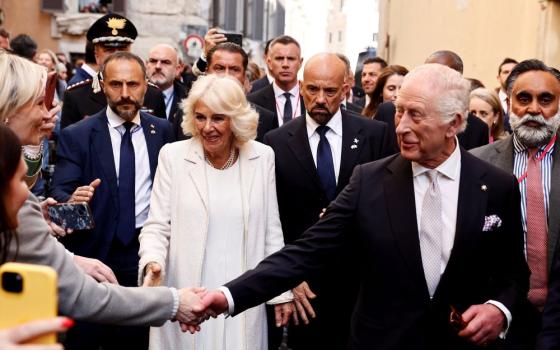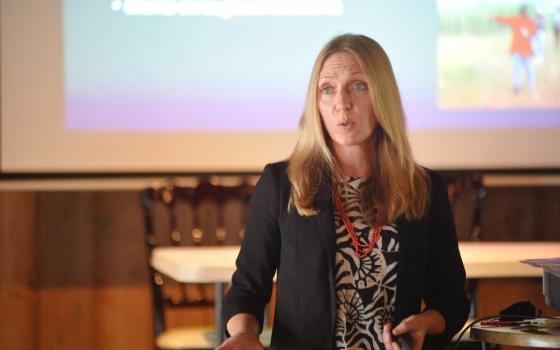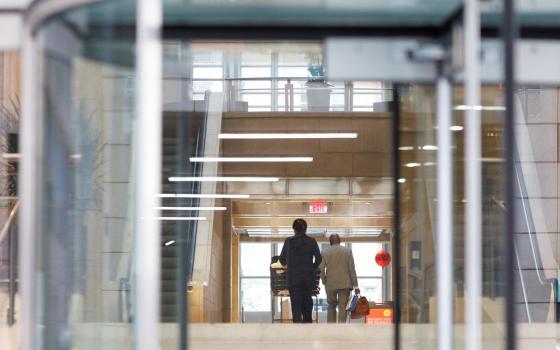In our immigrant family, there were many Stations of the Cross, depending on resonant circumstances -- fleeing from war, or surviving travails post-war, finding their ways through the refugee camps, making their way into a culture not at war, but with daily opprobrium toward immigrants.
The “full deck” of stations was used in times of confusion, hurt, betrayal and travail. We learned from our babushka grandmother Katerin, there were at least Thirty-Three Stations of the Cross in our family.
Long ago in the 13th to 18th centuries, many parts of the world had different numbers of stations, that is, meditation places to remember and learn from the struggle of the Christ.
It was only in the 18th century that papal decrees proscribed there would be only 14 stations from now on.
But, like most of the world Katerin, a peasant farmer and horsewoman, was never in a position to hear the back or foreground of papal decrees, and so she proceeded with the thirty-three stations instead.
When she did finally hear there were to be only fourteen stations -- and more than a century late -- (from me, as a little Catholic school girl,) she insisted in the most sensible way that there had to be more than fourteen, for this never-ending story is the story of the Essence and life and death... how can anyone possibly decide which part of such a deep story to leave out?
She came from a storytelling people, as do you and I. There is an old saying in my family: One cannot leave out essential parts of a deep story without making those same parts of one’s personal story go dark inside too. Knowing and self-knowledge depends on telling the whole story to the best of our abilities.
The thirty-three stations were taught to us as deep meditations and mediations, that is, opportunities for us to see exactly what to take up during the Passion, what to examine in ourselves, in our cultures, in our attitudes toward others, in our relationship especially to our teacher and to his teachings, remembering again the differences between soul and matter.
By hovering over these, by immersing in them, we could take up any one lens to peer through, or all. The only non-choice was to take up no place to stand on the Via Doloroso, the way of sorrows, and thereby to learn nothing, and thereby continue to lie in the grave, waiting, as Emily Dickenson put it, “for the moss to cover our lips and for our names to be erased.”
Instead, we were to be a living people who followed the bright living core underneath the overland religion.
In meditations on the Passion and how it pierces us, there are questions to and about ourselves and our worlds... to be asked and answered as best one can at each station....
-- Which soul(s) are we called/ shall we choose to be most like?
-- What endeavors shall we pledge to enjoin instead of absent ourselves from.
-- Which ones shall we resist with everything in us, and how?
-- Which shall we loyally embrace and enact without forgetting?
-- What specific steps shall we take to show up with the Light?
-- How shall we strive to live inside fullest Light?
And here are the thirty-three stations before we knew there were only fourteen... These are notes to what was recited, talked over, in little clumps at church as we moved through the stations’ plaques on the wall there. We looked like a tiny floating island of family... but finally, since so many with familial and work commitments needed to do “express” fast track Stations of the Cross, we began gathering at my grandmother’s attic home on “tar beach”, where we could spend the needed time with He “who did the time.”
The only caveat came more than halfway through the stations, when tiredness from being in the non-stop brutal-radiant story began to set in. Then we’d hear the gentle and heavily accented voice of Katerin, saying, “Don’t fall asleep, do not fall asleep like the ones in the garden, or we will have to start over. Awaken, awaken. Let us go on.”
The whole point? Remain awake. In more ways than one.
Thirty-Three Stations of the Cross
1. Wherein we learn about how we, and others, can cause torment and loneliness by the abandonment of the Light in the garden: All watchers fall asleep on the death vigil, leaving Jesus to anguish alone.
2. Wherein we learn we, and others, can cause profound loss by accepting the very small price of temporary worldly status: Betrayal by the double-speaking deceitful heart, opens the way for seizing and imprisoning the Light.
3. Wherein we learn here for ourselves, and about others, that there is no prison strong enough to hold the Light: He who is captured continues to teach anyway... “to live by the sword, is to die by the sword,” as He heals the severed ear of the slave.
4. Wherein we learn how we, and others, can take on the power of the mindless mob, how evil fire to condemn others jumps like fire from dry heart to dry heart: The freeing of Barab'bas.
5. Wherein we learn how we can conduct or become victims of unfair trials by forming a court of jealousy and fear instead of heart: The trial of Jesus where He is condemned to death.
6. Wherein we learn the ways of evil in which we ourselves, or others, try to break our supernatural knowings and graces, by scorning, taunting, disparaging, exiling and tormenting the Light, by bashing, by crippling, by purposefully seeking to make the Light bleed instead of radiate. Wherein we learn to endure: The scourging and the crowning with thorns, Jesus is mocked.
7. Wherein we learn about a certain underpinning of cowardice in ourselves and others, how hard it can be to stand up for the Light, and protect ourselves and our usual lives... at the same time: The running away of most of Jesus’s followers.
8. Wherein we learn that once the death gate is decreed unjustly, free will gives us choice about not what will occur next, but what attitude we will carry into this travail that will test/ teach others in need, that will keep us true to our Source: Jesus forced to drag his cross to Gol'gotha, the doorway to mortal death.
9. Wherein we learn how matters too hard for us or for others to handle can put us face to face with the bricks,... yet we struggle to and do rise again: Under the weight of the Cross, Jesus falls to the road the first time.
10. Wherein we learn that we and others carry Mary, Maria, Mir-yam’s truest mother-heart, even in times of abject fear and suffering: Jesus’s mother risks her life to push through the elbowing, jeering crowd to touch her Child.
11. Wherein we learn how we and others can overcome fear and be pressed into service to those whose bones are small, but whose burdens are big: A frightened man, Simon of Cyrene helps Jesus drag the Cross.
12. Wherein we learn that we and others are often called to “break the rules made by men” and give comfort to the suffering: Veronica risks her life and breaks taboo by removing her veil to wipe the blood from Jesus’s face.
13. Wherein we learn that even in severe loss, we and others will manage to rise again: Weakened by blood loss, Jesus stumbles and falls to the road beneath the weight of the cross for the second time.
14. Wherein we learn to grieve loss of light aloud and are told that without direct Light in coming days, so much will be lost: Women risk their lives to publicly grieve Jesus’s horrible struggle to push onward; He teaches them, even from the midst of his agony.
15. Wherein we learn that even with nothing left in us during travail, there is still something in us that helps us rise and go forward: Jesus, exhausted, falls for the third time.
16. Wherein we learn how we and others will fight over the scraps of the Light’s outer shell, rather than the full Living Light standing before us. Wherein we learn tearing away outer trappings of the Light merely unclothes the Light... making the Light shine even further and all the more, even though some try to pit us and others against each other to see who gets the biggest piece of what does not matter: Jesus is stripped of his clothing and soldiers gamble for his blood-soaked garments.
17. Wherein we learn how we ourselves or others may force innocence to its knees, hammering it until it is helpless and fastened tight into the place and shape of the Light seeming the least of what has ever lived: Jesus is forced to lie down on the timbers of the cross and grim muscled men who are not affected by horrible cries of pain from souls, nail Him to the Cross.
18. Wherein we learn we never cease wanting clear water in our ways of loving others, even in the midst of the most egregious, even when we ourselves and others offer us only bitterness: Jesus asks for the water of life, but is given bitter gall to drink instead.
19. Wherein we learn for ourselves, and for others cared for or uncared for, that there is no such thing as “too late,” no such thing as “never”: Jesus enfolds who is called Dismas “the good thief.”
20. Wherein we learn that it sometimes takes enormous upheaval to return our fealty, and the loyalty of others, back toward the Light of the world; in earthquake, ground shifting under us, in darkened sky, we have chance to re-realize the Light exists truly and is life-changing, culture-changing; that what one or others have just murdered, is indeed the Center: The storm descends, Jesus commends his Spirit to God, the curtain is torn in two, the centurion awakens to another reality.
21. Wherein we learn that some will not be happy in killing the Light only, but must maim it in order to assure themselves there will be no more leakings of Light into the dark: Jesus’s body is mutilated; stabbed with a sword to not take any chances, to make sure He is dead.
22. Wherein we learn to show our broken hearts publicly as a holy act, learn to risk the tenderness of grief, and to practice carefulness of touch in order to carry the outwardly broken Light to its grave: Jesus is taken down from the Cross. The women risk their lives to receive Jesus’s body. Many of the crowd scream-weep their ways home, having been broken by seeing the Light murdered and helpless to prevent it.
23. Wherein we learn to ask to take charge, to lovingly receive whatever is left after loss, to care for the shatters, the parts, nonetheless: Joseph of Arimathe'a risks his life and begs Pilate for Jesus’s body which Joseph wraps with fragrant oiled bindings and thence carries to a cave in a garden.
24. Wherein we learn what it means to the soul to deny Whom we are taught by, Whom we say we love, how devastating this is to any who allow it: The cock crows as Peter the apostle denies Jesus for the third time; Peter’s soul wanders in grief and self-recrimination for a long time afterward.
25. Wherein we learn that there is work to be done in the world of spirit, even when dead, we are then able to be closest to that hidden world which often invisible to the superficially living: Jesus’s spirit descends into hell and commences the harrowing of hell.
26. Wherein we learn what we will risk when we love the Light above all: Mary Magdalene risks her life to come to Jesus’s hewn-rock tomb; the huge stone door is rolled away, angels tell her He is risen.
27. Wherein we learn we are given gifts in the midst of great loss: that to truly see is not only through the usual sense of outer sight, that to hear is not our only way of hearing: the Magdalene weeps over mistakenly thinking Christ’s body has been stolen by thieves; Jesus, as the gardener appears to her, asking, “Do you not recognize me?”
28. Wherein we learn again and again how being reunited with Beloved, overwhelms all other breakage, all other heartache: The Magdalene weeps with joy, “Rabbo'ni! my beloved teacher.”
29. Wherein we learn that each soul will find its own way to understand the “Light that can never die”: Thomas and the apostles refuse to believe the women have seen Christ, saying it is merely a story. Thomas must enter the wounds literally with his own material fingers and hands to learn.
30. Wherein we learn that we carry and live inside twelve special and observable gifts even as Christ becomes spirit to us: Christ hurls the twelve gifts of the Holy Spirit into all followers during the Pentecostal mysterium.
31. Wherein we learn dying is not the central story; the rising again is the central story of the soul, and of the Christ: Jesus ascends to heaven
32. Wherein we learn that the woman who stayed, the woman who remained, no matter what heartache, no matter all else, that she also rises in full spirit: The mother of God ascends to heaven
33. Wherein we learn from all these images and rememberings now in our minds and hearts, that now the Passion begins anew, this time as a worldly challenging of us-- mere human beings-- who still follow the Christ. We shall all learn too, the knack of death and return in our own ways while still here on earth. Over and over, in a microcosm of our Teacher, His mother, and by learning we all are in some part, also one of the Magdalenes, one of the las Marias, one of the Cyrenes, one the watching centurions, one of the repentant thieves, one of each of those who break the rules of men to risk their lives to live in the Light.
May the Light of the World return rapidly
and recognizably to each and every hungry heart...
yours, mine... everyone’s.
-----------------------------------------------------------------------------------
“Easter, Beauty and Truth Murdered: 33 Stations of The Cross” by Dr. C.P. Estés ©2009, All Rights Reserved. Permissions: Projectscreener@aol.com.


